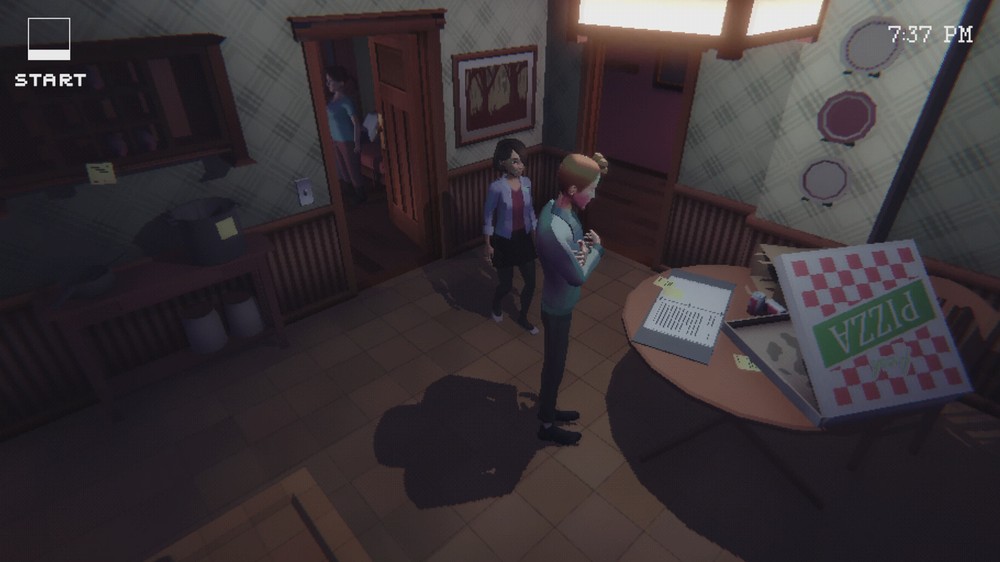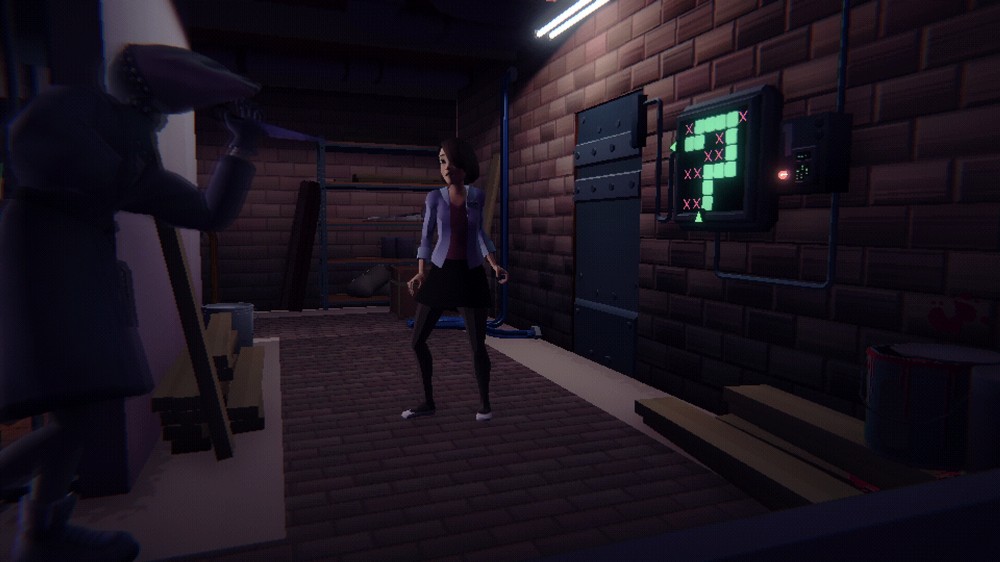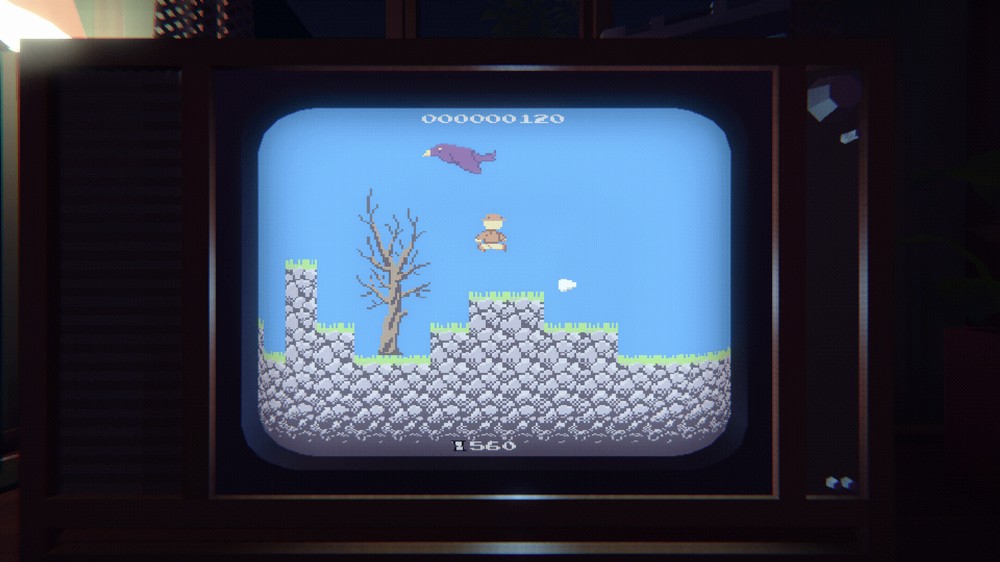It’s tough to talk about Homebody without spoiling things along the way. Spoiler heavy sections of this review will be marked appropriately. Reader beware.
Homebody is a classic horror puzzle game from Game Grumps, the long-time YouTube channel and developers of 2017’s dad dating sim, Dream Daddy. Moving from father coupling to horror, Game Grumps not only displays an ability to shift genres, but an ability to capture different moods with great effect. Homebody transports you back to the heyday of 90s horror with a single location setting, fixed camera angles, and a relentless killer hunting you. Yet, the scares are limited. Instead, the game focuses on creating a stressed-fueled environment and building up fully realized characters. Add in some puzzles that’ll have you grabbing a pen and paper and you’ve got a satisfying gameplay loop that will have you thinking about it long after you’ve reached the end.
Homebody follows Emily, a twenty-something shut-in who has moved to the city and lost contact with many of her loved ones. At the start of the game, she reunites with her college friends at a remote rental house to watch the Perseid meteor shower. You can feel the tension in the house immediately. The game perfectly captures that awkward feeling of reuniting with people you’ve failed to stay in touch with. There’s a disconnect between Emily and her friends. Hurt feelings, words unsaid, and survivor’s guilt roam the halls of the mysterious rental property. I was worried I would struggle to connect with the cast of characters, mainly due to a lack of voice acting. Those concerns were stomped out the more I interacted with everyone. The writing paints a clear image of each friend and Emily’s strained relationship with them. At the start of the night, Cliff, the grumpiest of the friends, hardly looks in Emily’s direction. As the night goes on, he warms to Emily’s presence, discussing work, life, and getting old. Things go from awkward to deadly when a masked killer locks you in the house and hunts you and your friends down one-by-one.

You’ll run around the house solving puzzles in the hopes of escaping death. Homebody’s puzzles dabble in pattern memorization, math, and timing. Things aren’t always clear right away, but the game does a good job piecemealing information out little by little and giving players room to have their own “AHA” moments. For example, the solution to an early Minesweeper puzzle comes back into play when you eventually need to access a powerbox. Connecting the dots between puzzles is easily the most satisfying experience. The game also hides clues in some fascinating ways, and messes with you in the process of hunting for clues. I won’t say too much on it, but I found myself tearing through materials that weren’t totally necessary, in search of clues.
I do wish there were more puzzle variety in the game’s short run, especially in the later half, when a specific puzzle type is reused a few times. The killer is present during most of your puzzle solving. You’re always at risk of catching a knife in the back and losing some progress. I never found this to be obnoxious though. The house is laid out in a way that you can always maneuver around the killer and create some space between you and them. There are no scripted jump scares in the entirety of Homebody. Any jump scare encountered was the result of rounding a corner into the killer, or being pulled out of a puzzle screen as I was being stabbed.

Major spoilers below.
Emily and her friends are eventually all murdered, but to her surprise, Emily awakens back to the moment she arrived at the rental property. Yep. Homebody is a time loop story. Emily remembers everything that happened from the previous night, but to her dismay, her friends are none the wiser. Making things worse, she can’t communicate anything that has happened to her friends. It’s a twist that plays well into a story that explores mental health, OCD, and depression. In the lead up to Emily’s arrival, she’s obsessing over everything that could go wrong in reuniting with her friends. Adding a killer to the mix and throwing Emily into a time loop is the most exaggerated version of “the worst thing that could happen,” but it communicates the type of mental loops Emily puts herself through daily.
The scares and death lose their luster when you realize it’s all part of the gameplay loop. You’re not going to hit all the puzzles in one run, it’s just not possible. Runs come down to making some progress before dying. Players have a journal that tracks all notes and points of interest throughout the house. These notes do not go away between runs. In addition, some puzzles only need to be completed once. This keeps the game flowing and makes dying mid-puzzle less frustrating. I also really enjoyed that your friends come in handy for solving some puzzles. An early powerbox puzzle may seem confusing at first sight, until you recall that Cliff used to work with powerboxes and can give you a rundown on how they work. If you’re stuck, the game offers hints between runs. These are actually less like hints and more like solutions. It caught me off guard the first time I agreed to get a hint but is still a nice feature for those that find themselves lost and just want progress.
When not giving you hints between runs, the game also dives a little deeper into its characters with short cutscenes from their previous get togethers. These are usually an indicator that you’re making progress in the house. They also deliver memorable moments that paint some of your friends in a different light. I’m tiptoeing around spoilers, but I will say the conversations in these scenes were impactful enough that once I was back in the house I ran to each character to try and talk with them about it.
End major spoilers

The house is as disheveled as the relationships between its guests. Odd contraptions and locked doors hint at the mysteries buried just out of sight. Multi-colored electric wires run along the walls, disappearing into the floors and ceilings. Rooms feel out of place, too big, and too small. Game Grumps does an amazing job of conveying space (or a lack of it) through their great use of fixed camera angles. Once the initial scares have run their course, the cameras take over in creating the suspense. One standout is the upstairs foyer area that leads into the upstairs hallway. The foyer is shot from the ceiling at a corner-angle, a shot that matches pretty close to a stairwell in the original Resident Evil. Moving from the foyer to the hallway gives us a tight angle that displays the low lit, deathtrap of a hallway. Transitions like these continuously have you flip-flopping from feeling small in one moment, to feeling trapped in the next. It’s unsettling.
My only real downers with Homebody are its length and replayability. Even if you explore every corner of the house and have every conversation, you’re looking at the five to six hours mark for completion. Once you’ve completed the campaign there’s not too much to return for unless you’re a speedrunner looking to shave time or an essayist gathering notes. The game leaves many aspects open to interpretation, so while you may not find a reason to return for another night in the house, you’ll find plenty to think about.

Homebody is a surprising transition from a developer that perfectly recaptures 90s survival horror, while also juggling a sensitive topic, and a few other surprises. It’s a game that wears multiple hats and does it well. Focusing on OCD and depression, it delivers a heartfelt story with memorable characters. It’s not the scariest game you’ll play, but the mood and atmosphere it captures will transport you back to your own awkward reunions and creepy AirBnB stories all in one swoop.











